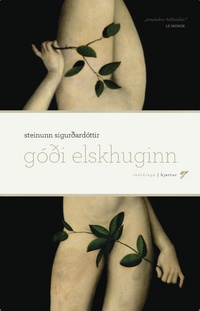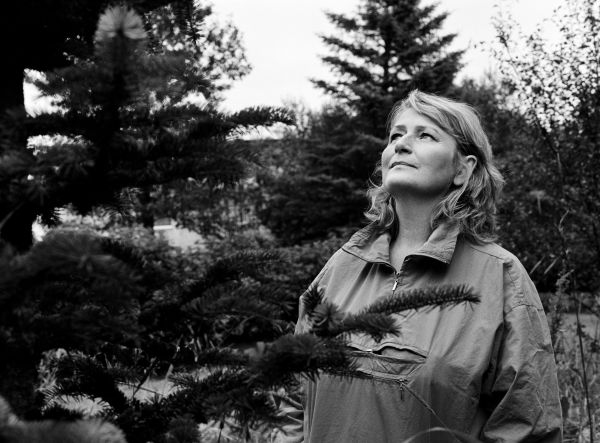The Good Lover
Setting a book loose on the world is an adventure
“As soon as the reader knows what to make of a book, it fails,” says the author Steinunn Sigurðardóttir in an interview with us. Her newest novel, The Good Lover, was published in German in early September.
 “As soon as the reader knows what to make of a book, it fails,” says the author Steinunn Sigurðardóttir in an interview with us. Her newest novel, The Good Lover, was published in German in early September.
“As soon as the reader knows what to make of a book, it fails,” says the author Steinunn Sigurðardóttir in an interview with us. Her newest novel, The Good Lover, was published in German in early September.
The book tells the story of one Karl Ástuson, a bachelor and businessman raised by an excessively loving mother. At twenty, his girlfriend Una suddenly leaves him, with no explanation offered. Seventeen years down the road, Karl has become a successful financial mogul who divides his time between America and France. However, despite the wealth and female attention he now enjoys, his earliest brush with love has left a void within Karl that he seems unable to fill.
He makes an impulsive decision to return to Iceland, hoping to bump into Una, and a series of coincidences leaves him at doorstep of his old sweetheart on a cold winter's nights, with no clear idea of what he should do. In his desperation, he phones another of his former lovers, the American psychiatrist and analyst Doreen Ash, hoping for some kind of advice. At the phone call's conclusion he takes another fateful decision – and decides to throw the dice.
The Good Lover, like Steinunn's previous works, examines “large” subjects indivisible from the human experience – love, time and death – but as the reviewer of literature.is points out, Steinunn manages to find a fresh take on these well-worn themes: “It's amazing to be able to write about love affairs without the clichés piling up, or the emotions described becoming overly lofty and remote… this is largely due to the author's distinctive blend of warmth and humour. Even though the work abounds in irony, it never turns sarcastic, and love plays neither a trivial nor saccharine role. Instead, it warms the reader's soul on a cold day.”
“As soon as the reader knows what to make of a book, it fails”
 “The idea for the work came from a name on a tombstone: Doreen Ash,” Steinunn says about the work's inception. “I can't remember where it was. Either in Scotland or just outside Paris. I dreamed of this woman, or her name, rather, and I knew this was a name that would stay with me for a long time. That prediction came true. We spent three years together, Doreen and I, while I was writing the book. And as a matter of fact, she took it over, unexpectedly. She writes the novel within the novel, which is also called The Good Lover.”
“The idea for the work came from a name on a tombstone: Doreen Ash,” Steinunn says about the work's inception. “I can't remember where it was. Either in Scotland or just outside Paris. I dreamed of this woman, or her name, rather, and I knew this was a name that would stay with me for a long time. That prediction came true. We spent three years together, Doreen and I, while I was writing the book. And as a matter of fact, she took it over, unexpectedly. She writes the novel within the novel, which is also called The Good Lover.”
The book is, in large part, a character study of a man who is raised by an excessively loving mother. What made you create such a character?
“The relationship between mother and son is so fascinating that I should get an award for exerting the self-control to not write about it until now. Upon reflection, I might want to make some of Doreen Ash's opinions on the matter my own. In any case, while I was writing I believed every word of what she had to say about the destructive influence that the mother's love can exert on the son.”
The story unfolds in an unpredictable way. It even has some of the trappings of a fairy tale. Which leads us to the question: Do the characters live happily ever after?
“Setting a book loose on the world is an adventure in its own right. Sometimes, people make a book of mine into something completely different than I originally intended. Some of my sharpest readers have their doubts about the “happy ending” of The Good Lover. And I'm pleased with that.”
It has been called an underhanded sort of novel.
I'm glad to hear people say that. As soon as a reader knows what to make of a book, it fails. One of the greatest reading experiences I ever had was The Saga of the Sworn Brothers (orig. Fóstbræðra saga). There was no earthly way of knowing whether the author thought the protagonists were heroes or imbeciles. Maybe they were both. And maybe that's what it all comes down to: not either, but both.
What is the trick to treating love in fiction, without “the clichés piling up”?
Who honestly believes that it's even possible to exhaust the big themes – love, time, death? It can't be done. It isn't even possible to exhaust the subject landscape. Landscape may not change, and it may have been masterfully described before. Nevertheless, we need new ways of getting it across, because while the landscape has stayed the same, we have not.”
“I hardly know where to start”
For the past few weeks, Steinunn has been on a reading tour of Germany to promote the book. “It's been like a dream, in every single place, whether it's a metropolis or a small town,” she says of the reception.
“Lots of people arrive who are silent in the right places, laugh in the right places, buy the books and ask to have them signed. It's wonderful to have this direct contact with readers, and I'm happy that my German has come in handy, although I do wish it was better. When readers come to me saying that they've read every one of the six books by me in German, I have to work hard to keep the tears out of my eyes.
“It's also unbelievable to see how devoted people in each place are to doing the best they can for literature, how much they're willing to sacrifice. And on these trips, I've experienced such stories that I hardly know where to start.
“There was the lady in the bell tower of Christianskirche in Hamburg. She played the church bells, and commissioned a work from my husband, Þorsteinn Hauksson. Instead of declining, he wrote a work on the spot, “Miniatures”, which she then immediately premiered. Then there was the sparkling wine cellar in Geissensheim, where 250 people turned up for a reading. They make a red sparkling wine there, very dry, which is unique in the world as far as I know. And Bad Berleburg, the landlocked town an hour away from any highway. There lives the sister of Queen Margaret of Denmark, with old Queen Ingrid a frequent visitor there in her day. I thought it was a lie when I first heard of it. To make a long story short: I have had frequent occasions for wonder on the tour, and encounters with wonderful people I'll never forget.”
Interview: Davíð K. Gestsson
Translation: Steingrímur Teague
Photo: Kristinn Ingvarsson
